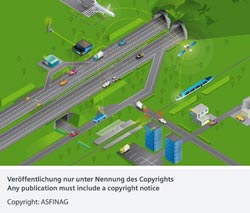Traffic Control: Cars Warn Each Other of Danger

<br><br>
The system allows participants to exchange information with one another, as well as with infrastructure components such as traffic lights or dynamic signs – all in realtime and at high speeds. A test field (Testfeld Telematik) for the system was recently presented at the ITS World Congress in Vienna.
Siemens equipped this test field, a 45-kilometer triangular stretch of interstate highway in the south of the Austrian capital, with 150 sensors and more than 150 traffic cameras. The units permanently monitor road conditions, the traffic situation, and the weather. Visitors to the ITS congress were able to see how intelligent vehicles use wireless communication to inform drivers of other cars of potential dangers – for example, conditions of limited visibility or blind spots.
Corporate Technology – Siemens' global research department – developed vehicle-to-X demonstration units for highways, traffic light communication, and in-vehicle reception for the test field. The overall goal here is to create an “Internet on wheels,” whereby the vehicle-to-X communication system prototypes could later be incorporated into the existing highway and road infrastructure in Vienna. Among other things, this will make possible efficient, safe, and resource-conserving mobility in the future.
In such a setup, vehicles could warn each other to drive with caution after an accident occurs to ensure no other cars collide at the accident scene, for example. The system could also transmit information when a light turns red, which would allow other vehicles to reduce their speed in time and thus conserve fuel as well.
All vehicles and devices will be interconnected in the megacities of the future (Internet of Things). Standardized interfaces will enable them to exchange data with one another (machine-2-machine) and communicate with people.
For years now, Corporate Technology has been developing cooperative systems that are tested by the Siemens Mobility and Logistics Division as demonstration units. Siemens works on integrated solutions for both vehicles and traffic infrastructures.
Media Contact
More Information:
http://www.siemens.com/innovationnewsAll latest news from the category: Transportation and Logistics
This field deals with all spatial and time-related activities involved in bridging the gap between goods and people, including their restructuring. This begins with the supplier and follows each stage of the operational value chain to product delivery and concludes with product disposal and recycling.
innovations-report provides informative reports and articles on such topics as traffic telematics, toll collection, traffic management systems, route planning, high-speed rail (Transrapid), traffic infrastructures, air safety, transport technologies, transport logistics, production logistics and mobility.
Newest articles

A universal framework for spatial biology
SpatialData is a freely accessible tool to unify and integrate data from different omics technologies accounting for spatial information, which can provide holistic insights into health and disease. Biological processes…

How complex biological processes arise
A $20 million grant from the U.S. National Science Foundation (NSF) will support the establishment and operation of the National Synthesis Center for Emergence in the Molecular and Cellular Sciences (NCEMS) at…

Airborne single-photon lidar system achieves high-resolution 3D imaging
Compact, low-power system opens doors for photon-efficient drone and satellite-based environmental monitoring and mapping. Researchers have developed a compact and lightweight single-photon airborne lidar system that can acquire high-resolution 3D…





















